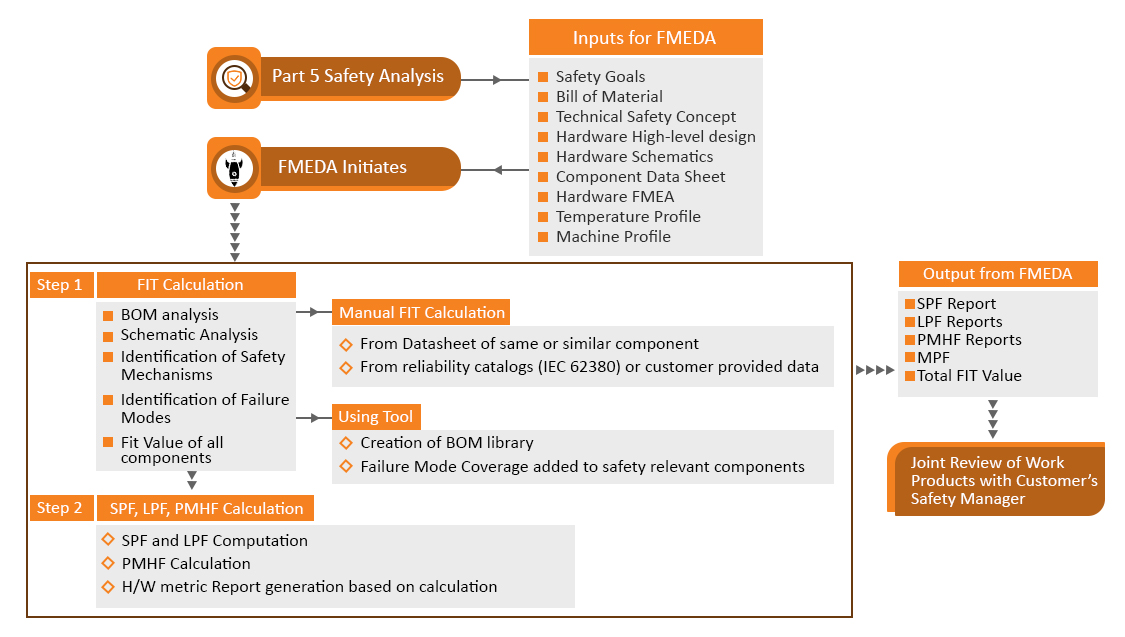About the Customer:
Our customer is a Tier-1 Automotive Supplier with expertise in diverse automotive product lines. The company caters to the Automotive OEMs across the Globe. The customer decided to partner with us for Functional Safety Consulting and implementation.
This Functional Safety project has been delivered for a prototype of an Electronic Control Unit (ECU) for a BLDC Electric Motor Control system. The project scope was to achieve ASIL-B compliance for this prototype.
Business Challenge:
The customer had planned to derive hardware metrics to help them achieve the product’s compliance to ASIL-B. While they were sure about the metrics they required, they wanted an in-depth consulting regarding the best approach (method) and the tool that will help them to accurately derive the metrics.
In the absence of an in-house QMS team, customer faced headwinds in progressing ahead with this project as per the framework of the ISO26262 standard.
Secondly, they wished to collaborate with a vendor with automotive domain experience, in order to effectively derive the hardware metrics for a motor control system ECU.
From the initial discussions, we understood that the customer needs hardware metrics (Single Point Failure Metrics, Latent Point Failure Metrics etc) for their ECU hardware components.
Embitel’s Solution:
Based on our previous experiences, we realized that FMEDA will be best suited to provide a single-view of these necessary metrics and make their journey to ASIL-B compliance a great value-add for their product.
Post a few discussions, the customer and our ISO26262 experts were on the same page and it was decided that we will go with FMEDA.
Our Functional Safety team got into action and initiated the process by gathering the inputs for FMEDA from the customers.
We also performed the gap analysis of the prototype at the customer’s location.
A detailed snapshot of FMEDA process execution

- Our team visited customer’s location to gather the inputs and perform the gap analysis for the existing prototype design.
- The inputs provided to us were as follows:
- Safety Goals from HARA.
- Hardware Architecture.
- Hardware Schematics.
- Bill of Materials (BOM).
- Datasheet for the components.
- Safety mechanism in the hardware.
- FMEA- Safety Relevant and Non-Safety Relevant components.
- We imported the BOM details to FMEDA form, to identify Safety Critical and Non-safety critical components.
- FIT Value was calculated by the tool based on IEC 62380 catalog.
- Safety Mechanisms and Diagnostics were now added to the FMEDA form in the tool for each of the components.
- Based on all these inputs, we calculated the Single Point Failure Metrics, Latent Point Failure Metrics, and PMHF.
- Joint review of the work products with the customer’s safety manager was done followed by delivery of work products and specific hardware failure metrics.
The final deliverables were:
- FMEDA reports.
- Single Point Failure Metrics (SPFM) Report.
- Latent Point Failure Metrics (LPFM) Report.
- GAP Analysis Report.
- Probability Metric of Hardware Failure (PMHF) Calculation Report.
Team Structure for the FMEDA project at Embitel:

Embitel’s Impact:
The customer was able to identify the gaps in the hardware design in the prototype and could resolve them. Hardware Metrics from the FMEDA performed on the hardware components established the credibility of the motor control system ECU as an ASIL B compliant design.
FMEDA reports delivered by our team would serve as an ASIL-B competency evidence to win the trust of the target OEMS of our customers. This project also helped our customer integrate Functional Safety Process as part of their organization’s product design culture.
Tool and Technologies:
- SOX Tool- A multi-faceted workbench that can perform HARA, FMEA, FTA, and FMEDA etc.
- IEC 62380- The catalog behind the SOX tool. It gives the FIT value of the hardware components.


